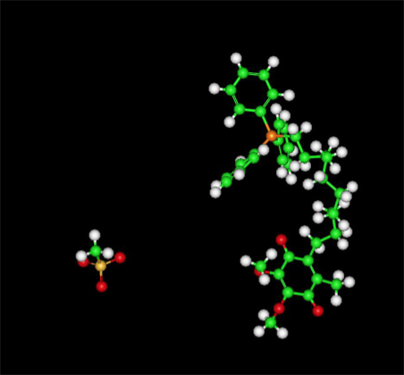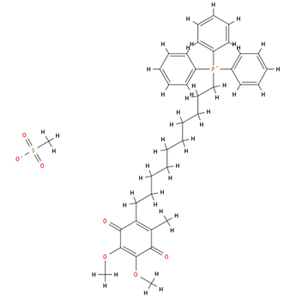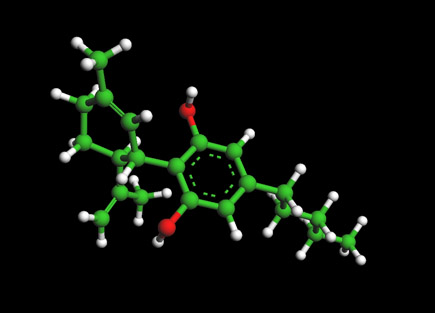MitoQ--Anti-Aging and Senolytic Properties

Image: MitoQ - Ball and Stick Model
To View the MitoQ Molecule in 3D --->> with Jsmol
Beta MitoQ is an antioxidant that targets the mitochondria in living cells in order to protect them from oxidative damage. Mitochondria are an essential oranelle in most cells that use oxygen to break down molecular carbohydrates and fat to produce energy in the form of ATP. MitoQ has undergone clinical trials in humans. Most recently it has been shown that ".." Older adults who take a novel antioxidant molecule MitoQ that specifically targets cellular powerhouses, or mitochondria, see age-related vascular changes reverse by the equivalent of 15 to 20 years within six weeks, according to new University of Colorado Boulder research. .." see article.

MitoQ Molecular Structure
Reactive Oxygen Species (ROS) formed in Mitochondria
In a biological context, ROS are formed as a natural byproduct of the normal metabolism of oxygen and have important roles in cell signaling and homeostasis. Examples include peroxides, superoxide, hydroxyl radical, and singlet oxygen. However, during times of environmental stress (e.g., UV or heat exposure), ROS levels can increase dramatically. This may result in significant damage to cell structures. Cumulatively, this is known as oxidative stress.
ROS are produced intracellularly through multiple mechanisms. Mitochondria convert energy for the cell into a usable form, adenosine triphosphate (ATP). The process in which ATP is produced, called oxidative phosphorylation, involves the transport of protons (hydrogen ions) across the inner mitochondrial membrane by means of the electron transport chain. In the electron transport chain, electrons are passed through a series of proteins via oxidation-reduction reactions, with each acceptor protein along the chain having a greater reduction potential than the previous. The last destination for an electron along this chain is an oxygen molecule. In normal conditions, the oxygen is reduced to produce water; however, in about 0.1–2% of electrons passing through the chain, oxygen is instead prematurely and incompletely reduced to give the superoxide radical (•O− 2).While superoxide radical itself is only moderately reactive it can easily be converted into more damaging molecules.
Mitochondria are the major source of the free radical superoxide within cells, mitochondrial oxidative stress is thought to be a major contributing factor underlying a wide range of diseases and pathologies including: heart attack, stroke and sepsis, and also chronic disorders such as diabetes, metabolic syndrome, inflammation, and many of the degenerative processes and diseases associated with ageing such as Parkinson's disease and Alzheimer's disease.
Antioxidant Properties of MitoQ
The antioxidant component of MitoQ is the same ubiquinone as found in Coenzyme Q 10 . Within mitochondria the ubiquinone part of MitoQ is rapidly activated to the active ubiquinol antioxidant by the action of the enzyme Complex II (also called succinate dehydrogenase) in the mitochondrial respiratory chain. After detoxifying a free radical or other ROS the ubiquinol part of MitoQ is converted back to ubiquinone, which is then recycled back to the active antioxidant by Complex II within the mitochondria. It is this combination of a thousand-fold concentration within mitochondria, coupled to its conversion to the active antioxidant and recycling back to the active antioxidant after detoxification of a free radical that makes MitoQ such an effective mitochondria-targeted antioxidant.
Bioavailability of MitoQ
Unlike many other forms of CoQ10, MitoQ is water soluble and demonstrates optimal oral bioavailability. Peak plasma levels are achieved in less than an hour. MitoQ is able to quickly penetrate all biological membranes, including the blood-brain barrier.
Abstracts:
7 June 2018 Chronic Supplementation With a Mitochondrial Antioxidant (MitoQ) Improves Vascular Function in Healthy Older Adults.
Excess reactive oxygen species production by mitochondria is a key mechanism of age-related vascular dysfunction. Our laboratory has shown that supplementation with the mitochondrial-targeted antioxidant MitoQ improves vascular endothelial function by reducing mitochondrial reactive oxygen species and ameliorates arterial stiffening in old mice, but the effects in humans are unknown. Here, we sought to translate our preclinical findings to humans and determine the safety and efficacy of MitoQ. Twenty healthy older adults (60-79 years) with impaired endothelial function (brachial artery flow-mediated dilation <6%) underwent 6 weeks of oral supplementation with MitoQ (20 mg/d) or placebo in a randomized, placebo-controlled, double-blind, crossover design study. MitoQ was well tolerated, and plasma MitoQ was higher after the treatment versus placebo period (P<0.05). Brachial artery flow-mediated dilation was 42% higher after MitoQ versus placebo (P<0.05); the improvement was associated with amelioration of mitochondrial reactive oxygen species-related suppression of endothelial function (assessed as the increase in flow-mediated dilation with acute, supratherapeutic MitoQ [160 mg] administration; n=9; P<0.05). Aortic stiffness (carotid-femoral pulse wave velocity) was lower after MitoQ versus placebo (P<0.05) in participants with elevated baseline levels (carotid-femoral pulse wave velocity >7.60 m/s; n=11). Plasma oxidized LDL (low-density lipoprotein), a marker of oxidative stress, also was lower after MitoQ versus placebo (P<0.05). Participant characteristics, endothelium-independent dilation (sublingual nitroglycerin), and circulating markers of inflammation were not different (all P>0.1). These findings in humans extend earlier preclinical observations and suggest that MitoQ and other therapeutic strategies targeting mitochondrial reactive oxygen species may hold promise for treating age-related vascular dysfunction.
12 September 2019 The mitochondria-targeted antioxidant MitoQ inhibits memory loss, neuropathology, and extends lifespan in aged 3xTg-AD mice.
Oxidative stress, likely stemming from dysfunctional mitochondria, occurs before major cognitive deficits and neuropathologies become apparent in Alzheimer's disease (AD) patients and in mouse models of the disease. We previously reported that treating 2- to 7-month-old 3xTg-AD mice with the mitochondria-targeted antioxidant MitoQ (mitoquinone mesylate: [10-(4,5-Dimethoxy-2-methyl-3,6-dioxo-1,4-cyclohexadien-1-yl)decyl](triphenyl)phosphonium methanesulfonate), a period when AD-like pathologies first manifest in them, prevents AD-like symptoms from developing. To elucidate further a role for mitochondria-derived oxidative stress in AD progression, we examined the ability of MitoQ to inhibit AD-like pathologies in these mice at an age in which cognitive and neuropathological symptoms have fully developed. 3xTg-AD female mice received MitoQ in their drinking water for five months beginning at twelve months after birth. Untreated 18-month-old 3xTg-AD mice exhibited significant learning deficits and extensive AD-like neuropathologies. MitoQ-treated mice showed improved memory retention compared to untreated 3xTg-AD mice as well as reduced brain oxidative stress, synapse loss, astrogliosis, microglial cell proliferation, Aβ accumulation, caspase activation, and tau hyperphosphorylation. Additionally, MitoQ treatment significantly increased the abbreviated lifespan of the 3xTg-AD mice. These findings support a role for the involvement of mitochondria-derived oxidative stress in the etiology of AD and suggest that mitochondria-targeted antioxidants may lessen symptoms in AD patients. source
12 July 2018 The Effect of MitoQ on Aging-Related Biomarkers: A Systematic Review and Meta-Analysis
Mitochondria are metabolically active organelles that produce significant reactive oxygen species, linked with aging and degenerative diseases. In recent years, particular focus has been put on mitochondria-targeted antioxidants, to decrease the concentration of reactive oxygen species and help alleviate the accumulation of oxidative damage and associated aging. MitoQ is a mitochondria-targeted antioxidant of which is reported to support healthy aging. The aim of this systematic review is to investigate the effects of MitoQ on oxidative outcomes related to the aging process. A predeveloped search strategy was run against MEDLINE (Ovid), EMBASE (Ovid), and CINAHL databases, which identified 10,255 articles of interest, with 27 of these finalised for use after screening. Three outcomes had sufficient data to meta-analyse nitrotyrosine concentration (190 animals, SMD −0.67, 95% CI (−1.30, −0.05), p = 0.04), membrane potential (63 animals, MD 11.44, 95% CI (1.28–21.60), p = 0.03), and protein carbonyl concentration (182 animals, SMD −0.13, 95% CI (−0.44, 0.18), p = 0.41). MitoQ intervention produced a statistically significant reduction in nitrotyrosine concentration and increased membrane potential. MitoQ may be of some benefit in alleviating oxidative stress related to aging. see full publication.
Anti-Aging and Senolytics Home Page
- What is Anti-Aging Medicine
- What is Senescence?
- What are Senolytics?
- About Caloric Restriction
- Mtor and Rapamycin
- The IKK/NF-κB signaling pathway in aging
- Exercise and Anti-Aging
- Meditation and Anti-Aging
SENOLYTIC AND ANTI-AGING MOLECULES
RAPAMYCIN ---The mechanistic target of rapamycin (mTOR) pathway has a central role in cell activation...
METFORMIN -- The diabetes drug metformin used by some for anti-aging may diminish benefits of aerobic exercise...
QUERCETIN-- AND WITH DASATINIB--The senolytic cocktail, dasatinib plus quercetin, which causes selective elimination of senescent cells...
FISETIN--Of the 10 flavonoids tested, fisetin was the most potent senolytic...
EGCG- The most active component of green tea....
NAD BOOSTERS --'...The cells of the old mice were indistinguishable from the young mice, after just one week of treatment...
SULFORAPHANE-- An isothiocyanate present in cruciferous vegetables activates antioxidant and anti-inflammatory responses by ...
UROLITHIN --Metabolite of Pomegranate compound with anti-aging effects passes human trial...
MITO-Q -- A water soluble fomr of CoQ10 that has excellent absorption and high bioavailability...
HONOKIOL - A bioactive natural product derived from Magnolia Bark have demonstrated ...
CURCUMIN AND ANALOGS -Recent research is focused on the design and synthesis of curcumin analogs as antiproliferative and anti-inflammatory agents...
BERBERINE --berberine has recently been reported to expand life span in Drosophila melanogaster, and attenuate premature cellular senescence
N-ACETYL-CYSTINE (NAC)--"...pretreatment with NAC increased glutathione levels in the older cells and largely helped offset that level of cell death..."
PIPERLONGUMINE - A natural product from the Long pepper with high bioavailability...
RESVERATROL AND PTEROTSILBINE -- Pterostilben chemically similar to resveratrol bute differs from resveratrol by exhibiting increased bioavailability (80% compared to 20% in resveratrol)
SPERMIDINE--Spermidine delays aging in humans ...
ALLICIN -- Allicin is a compound produced when garlic is crushed or chopped. ...
VITAMIN D3 -- Production of the active forms of Vitamin D are reduced by 50% as a result of an age-related decline
VITAMIN K-- evidence suggests vitamin K has an anti-inflammatory action
TOCOTRIENOL(AND WITH QUERCETIN) --Tocotrieniols have been found to exert a synergistic antitumor effect on cancer cells when given in combination....
HSP-90 INHIBITORS --As a novel class of senolytics
The Cannabidiol Molecule
Cannabidiol (CBD is the major non-psychoactive component of Cannabis and is being looked at by major drug and consumer companies for various medical and social uses.